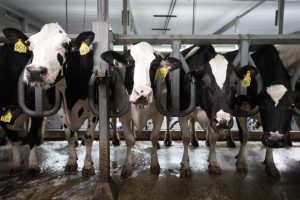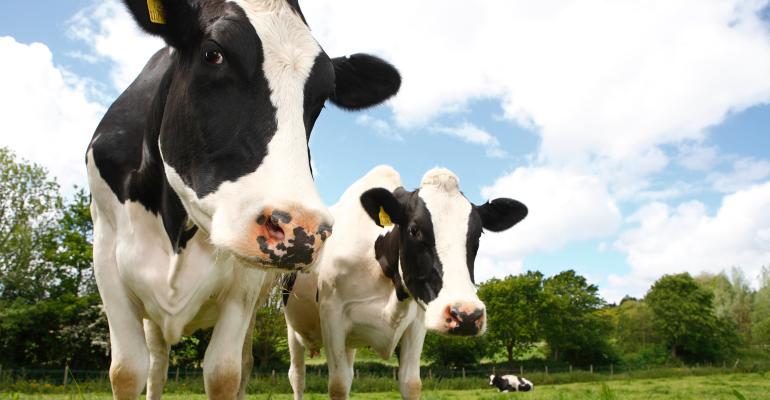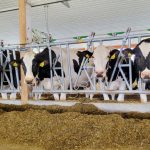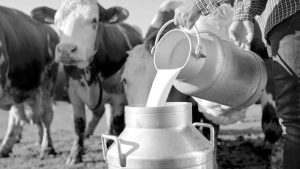
Severe drought, particularly in the West, has reduced forage supplies and driven feed prices higher, according to Bob Cropp, University of Wisconsin Extension dairy economist.
“Corn and soybean meal prices are much higher than a year ago,” Cropp says. “With higher feed costs driving tighter margins, dairy producers are likely to further reduce cow numbers, and milk per cow may be dampened some.”
USDA’s milk production report estimated August milk production to be 1.1% higher than a year ago. “This is the first time the growth in milk production has been below 2% since March,” Cropp notes.
Declining cow numbers
Milk cow numbers have declined for three consecutive months. August cow numbers fell 19,000 from July and 29,000 from May. The number of cows was still 1.1% higher than a year ago. Just nine of the 24 reporting states had fewer milk cows than a year ago. The largest reductions were in New Mexico, down 15,000 head, and in Washington, down 10,000 head.
Adverse weather impacted milk per cow, with no increase over a year ago. Ten of the 24 states reported milk per cow lower than a year ago, according to USDA.
South Dakota led all states in increased milk production, up 16.2% from 22,000 more cows and higher milk per cow. However, for the five leading dairy states, the increase in milk production was lower than in recent months:
California at 0.7%
Wisconsin at 2.6%
Idaho at 1.1%
New York at 0.3%
Texas at 3.2%
Seven of the 24 states reported less milk production than a year ago, and all seven had fewer milk cows. The monthly increase in milk production from the prior year is likely to continue to decline for the remainder of the year and into next year, Cropp says. Dairy producers are experiencing tight margins with higher feed costs.
Compared to August, September prices for dry whey remained unchanged, with averages higher for:
Butter, up 11 cents per pound
nonfat dry milk, up 8 cents
barrel cheese, up 5 cents
40-pound cheddar, up 4 cents
“With higher dairy product prices, the September Class III price will average $16.60, compared to $15.95 for August, and Class IV about $16.50, compared to $15.92 for August,” Cropp says.
Outlook for year
What can we expect for milk prices for the remainder of the year?
“Butter and cheese prices normally increase, as do milk prices September through November,” Cropp says. “Milk production is seasonally lower late summer — schools open, increasing beverage milk sales, and dairy product buyers increase purchases of butter and cheese to build stock levels for the strong seasonal demand from Thanksgiving through Christmas.
“We can expect price increases this year, but the increase maybe dampened by increased cheese production, relatively high stock levels, and possibly some setback in food service if the surge in cases of the Delta virus and mask mandates make consumers more reluctant to eat out and attend public events,” he says.
The latest dairy product report showed July production of American cheese up 2.3% from a year ago, and total cheese production up 3.5%. July 31 stock levels show American cheese stocks were up 4.2% from a year ago, and total cheese stocks were up 4.1%.
“Despite some possible impact of the Delta virus, cheese sales should remain strong and higher than a year ago,” Cropp says. “With more eating out rather than home-prepared meals, beverage milk sales have been running below a year ago. Beverage milk sales for July were 6.3% lower than a year ago, with year-to-date sales 5.3% lower. Butter sales may also not be as high, as butter sales were strong a year ago with more home-prepared meals.”
Robust dairy exports
Dairy exports have been a positive factor for milk prices and are expected to continue for the remainder of the year, Cropp says. U.S. dairy product prices remain price competitive to other major exporters.
“Milk production among other major exporters is expected to be no more than 1% higher than a year ago,” Cropp says. “July U.S. export volume on a milk solids-equivalent basis was 7% higher than a year ago — the sixth straight monthly increase. Increased exports to China and Mexico lead the way.”
Nonfat dry milk and skim milk powder exports were 3.1% lower due to reduced sales to Southeast Asia, which may be partially explained by continued congestion at California ports. But whey product exports were up 17.8%, cheese exports up 26.8% and butterfat exports up 86.1%, according to USDA.
“As of now, it seems reasonable that Class III could be $16.60 for September, $17.25 for October and peaking around $17.60 for November, and falling back to $17.40 for December,” Cropp says.
Current Class III futures are not this high, being in the low $17s October through December, he adds. Class IV could be in the high $16s to low $17s September through December.
“If milk production slows down more than expected and domestic sales are higher, along with strong exports, prices could end up higher,” Cropp concludes.























